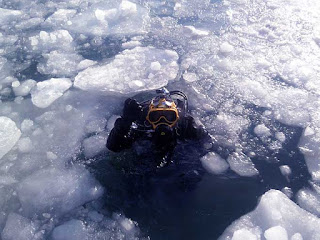how to ice diving
 |
| image source : https://www.divein.com/wp-content/uploads/ice-diving-signal.jpg |
Ice diving as the name is said, is diving under an ice. it a type of penetration diving.. Because diving under ice places the diver in an overhead environment typically with only a single entry/exit point, it requires special procedures and equipment. Ice diving is done for purposes of recreation, scientific research, public safety (usually search and rescue/recovery) and other professional or commercial reasons.
The hazards of ice diving are getting lost under the ice, hypothermia, and regulator failure due to oxygen freezing. Scuba divers are generally tethered (guide line) for safety. This means that the diver wears a guide line harness to which a line is secured, and the other end of the line is secured above the surface and monitored by an attendant. Surface supplied equipment inherently provides a tether, and reduces the risks of regulator first stage freezing as the first stage can be managed by the surface team, and the breathing gas supply is less limited. For the surface support team, the hazards include freezing temperatures and falling through thin ice.
 |
| image source : https://www.scubadiving.com/sites/scubadiving.com/files/styles/opengraph_1_91x1/public/images/2016/10/ice-diving-underwater-wreck-teaser.jpg?itok=oJrhOl98 |
For the professional diver it is a high risk environment requiring additional safety measures. Ice diving is a team diving activity because each diver's lifeline requires a line tender. This person is responsible for paving out and taking in line so that the diver does not get tangled, and for rope signal communications with the diver(just like how we use the safety line on board ship to our firemen). Professional teams will also require a stand-by diver and diving supervisor
Under some circumstances a guide line can be used as a reference for the divers to find the hole after the dive or in an emergency in a similar way to cave diving or wreck penetration instead of a lifeline.
Typical procedure for a scuba dive under ice:
- A snow shovel is used to clear the snow and ice from the area.
- An ice saw or a chain saw is used to cut a hole in the ice.
- A weatherproof area is used for the divers to suit up.
- The diver and tender on the surface are connected by a rope lifeline and harness. The harness is typically put on over the dry suit but under the BC or other buoyancy device so that the diver remains tethered even if he or she must remove the air cylinder or buoyancy control device. The harness fits over the shoulders and around the back such that the tender on the surface can, in an emergency, haul an unconscious diver back to the hole. The harness should not be able to slide up or down the diver's torso when pulled in line with the body.
- Rope signals or voice communications systems must be used.
- A roped standby diver is ready on the surface.
- One or two divers may dive at the same time from the same hole, each with his or her own rope. Using two ropes runs little risk of getting tangled together, but using three significantly increases this risk.
- If the regulator free-flows and freezes, the diver should close it down and switch to the backup, and terminate the dive.
- When diving in pack ice(falling ice), the surface team must constantly monitor ice movement to ensure that the exit is not compromised.
- The diver must ensure that there is always a positive indication of the route to the exit area. A tether to a surface tender is usually preferable as it can be used to communicate, but if this is not practicable a reel and distance line is an alternative.
- The risk of attack by predators and aggressive wildlife should be considered. Polar bear, walrus, and leopard seal are potential hazards within their ranges.
- Gas management for an overhead environment is appropriate.
- Deployment of a single tethered scuba diver is a reasonably safe alternative to free-swimming buddy team diving. The tethered scuba diver is equipped with a full-face mask with voice communications, high capacity scuba air supply, and an independent emergency air supply. A lifeline with communications cable is secured to a body harness on the diver and is handled by a surface tender who is in constant voice communication with the diver. A similarly equipped standby diver is available on the surface.
 |
| imge source : http://ice-diving.divescover.com/images/regions/0/0/2/3/4/00234_b.jpg |
 |
| image source : http://www.uwphotographyguide.com/images/jw-ice-8.jpg |
Surface team.
- Adequate thermal protection must be provided to tenders and standby divers.
- Warm waterproof shoes.
- Warm anorak for cold weather.
- Warm cap covering the ears.
- Sunglasses with a UV filter to protect the eyes in sunny days.
- Lip-care stick and cream to protect hands and face against cold and wind.
- A device like crampons to aid in traction on ice. especially when cutting the hole or carrying gear
(information source : https://en.wikipedia.org/wiki/Ice_diving )


Comments
Post a Comment